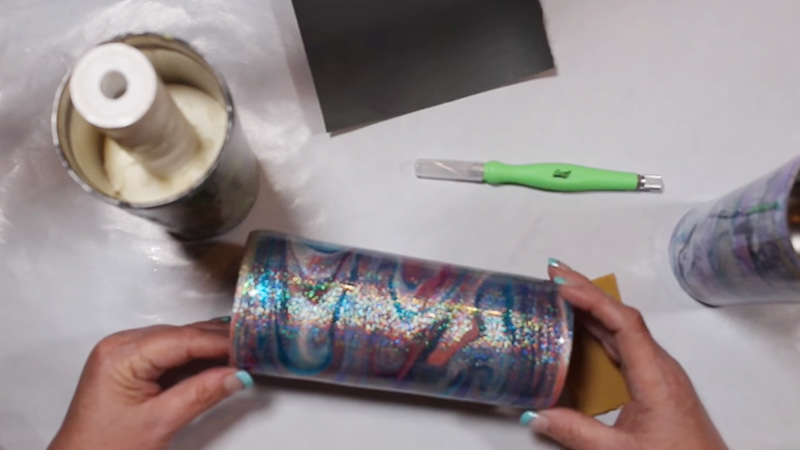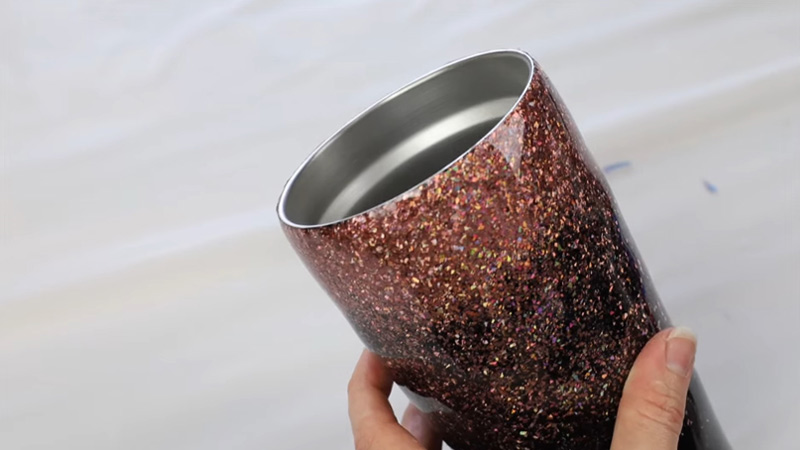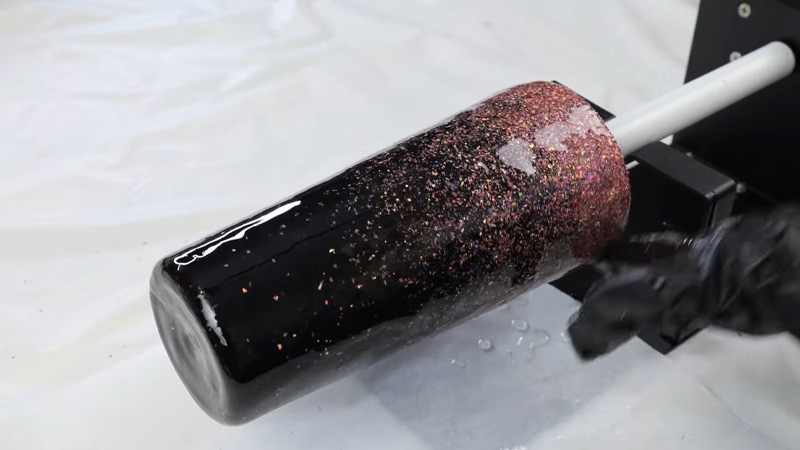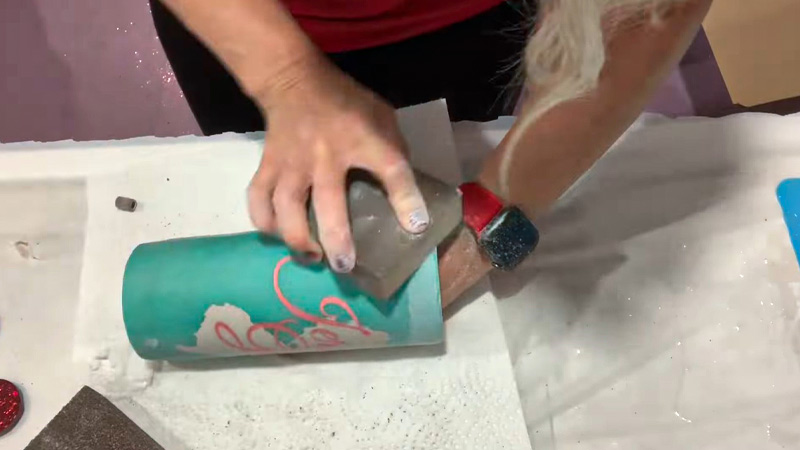Epoxy-coated tumblers have taken the crafting world by storm, offering a creative canvas for personalization. However, the frustration of epoxy separating from the tumbler’s surface is a common issue that many crafters face.
If you’ve ever wondered, “Why is my epoxy separating on my tumbler?” you’re not alone. This blog post will delve into the root causes behind this problem, exploring factors like improper surface preparation, curing conditions, and epoxy quality.
We’ll also provide practical tips and techniques to prevent epoxy separation and ensure your tumbler projects stand the test of time. Understanding the science and art of epoxy adhesion is the key to achieving flawless, long-lasting results in your crafting endeavors.

Why is My Epoxy Separating on My Tumbler?
Well, while working with epoxy resin, many of you just get disappointed and think about why is my epoxy resin separating. This part will tell you all about this question.
Epoxy separation refers to the phenomenon where the components of an epoxy resin, typically the resin and hardener, begin to separate before or during the curing process.
This can result in an epoxy mixture that doesn’t cure properly and may exhibit reduced strength and adhesion. Several factors can contribute to epoxy separation:
Contaminants on the Surface of the Tumbler
This is one of the most common causes of epoxy separation on tumblers. Any contaminants, such as dust, oils, or even fingerprints, can disrupt the surface tension of the epoxy, causing it to separate from the tumbler.
This can result in a poor bond between the epoxy and the tumbler, leading to a weak and uneven finish.
Improper Mixing of the Epoxy
Another common cause of epoxy separation is improper mixing of the epoxy. Epoxy is made up of two components: the resin and the hardener.
These components must be mixed together in the correct proportions and thoroughly blended to ensure a proper bond. If the epoxy is not mixed properly, it can separate into its component parts and not bond properly to the tumbler.
Temperature and Humidity
The curing process of epoxy is sensitive to temperature and humidity. If the temperature is too low or too high, or if the humidity is too high, it can cause the epoxy to separate. This is because the curing process is sensitive to changes in the environment and can be affected by ambient temperature and humidity.
Contaminated or Old Materials
Contaminants such as moisture, dust, or other foreign particles can affect the curing process and cause separation. Additionally, using old or expired epoxy components can lead to performance issues.
Humidity and Moisture
Epoxy is sensitive to moisture, and exposure to high humidity levels can introduce water into the mixture, disrupting the curing process and causing separation. Proper storage in a dry environment is essential.
Incompatible Materials
Some epoxy formulations may not be compatible with certain additives, pigments, or fillers. The introduction of incompatible materials can disrupt the chemical balance, leading to separation.
Insufficient Mixing Time
Rushing the mixing process can result in insufficient blending of the resin and hardener. It’s essential to follow the recommended mixing times provided by the manufacturer to ensure a homogenous mixture.
Underlying Surface Issues
The surface to which the epoxy is applied can impact its performance. If the substrate has not been properly prepared, cleaned, or primed, it can affect the epoxy’s ability to adhere, leading to separation.
Improper Application Conditions
Applying epoxy in unfavorable conditions, such as extreme temperatures or high humidity, can impact its curing and bonding properties.
It’s important to adhere to the recommended application conditions specified by the epoxy manufacturer.
These are the main causes of epoxy separation on tumblers. By understanding these causes, we can take the necessary steps to prevent and solve the problem.
Tips to Prevent Epoxy Separation on Tumbler

Preventing epoxy separation on a tumbler, especially when working on projects like customizing drinkware, is crucial for achieving a durable and attractive finish.
Here are several steps you can take to prevent epoxy separation:
Follow the Manufacturer’s Instructions
Always adhere to the instructions provided by the epoxy manufacturer. This includes the recommended mixing ratio, application conditions (temperature and humidity), and curing times.
Deviating from these guidelines can lead to separation issues.
Measure Accurately
Accurate measurement of epoxy components is essential. Use precise measuring tools, such as graduated cups, to ensure the correct mixing ratio. Even slight variations can impact the curing process.
Thorough Mixing
Mix the epoxy components thoroughly, ensuring that the resin and hardener are well-blended. Use a slow, deliberate stirring motion and scrape the sides and bottom of the mixing container to incorporate all parts evenly.
Avoid Overmixing
While thorough mixing is necessary, avoid overmixing, as this can introduce air bubbles into the epoxy. Overmixed epoxy may not adhere well and could lead to separation.
Use Clean Tools and Containers
Make sure that the tools, mixing containers, and the tumbler surface are clean and free from contaminants. Any dirt, dust, or residue can interfere with the epoxy’s adhesion and curing.
Prepare the Tumbler Surface
Properly prepare the tumbler surface by cleaning it thoroughly and, if needed, scuffing or sanding to create a surface with better adhesion. Follow any surface preparation recommendations provided by the epoxy manufacturer.
Apply in a Controlled Environment
Choose an environment with stable temperature and humidity levels for epoxy application. Extremes in temperature or high humidity can impact the curing process and lead to separation.
Apply Thin Layers
Applying thin layers of epoxy allows for better control over the curing process. Thick layers can trap heat, potentially causing separation or other curing issues.
Remove Bubbles
Carefully remove any air bubbles that may form during the application process. This can be done by gently passing a heat source, such as a heat gun, over the surface to release trapped air.
Monitor Curing Conditions
Once applied, monitor the curing conditions. Ensure that the tumbler is kept in an environment that meets the recommended temperature and humidity levels throughout the curing period.
Inspect for Contamination
Periodically inspect the epoxy mixture for any signs of contamination. If you notice any foreign particles, discard the mixture and start with fresh components.
By carefully following these steps and paying attention to details, you can significantly reduce the risk of epoxy separation and achieve a smooth, durable finish on your tumbler project.
What to Do When Epoxy Separate from Tumbler?

If epoxy separates from a tumbler, it can be a challenging situation, but there are steps you can take to address the issue and potentially salvage the project. Here are six points to consider:
Assess the Severity
Examine the extent of the separation. If it’s a minor issue with small areas affected, you may have the opportunity to fix it.
However, if the separation is widespread or the epoxy hasn’t cured properly, it might be more challenging to rectify.
Prepare a New Epoxy Mixture
Discard the separated epoxy and prepare a new mixture following the manufacturer’s instructions.
Ensure accurate measurement of resin and hardener and thorough mixing to prevent a recurrence of the separation issue.
Reapply Epoxy
If the separation is localized or in specific areas, carefully reapply the new epoxy mixture to those sections.
Use a clean brush or applicator to ensure a smooth and even application. Take care to blend the new epoxy with the existing layer.
Smooth Out the Surface
While the epoxy is still in its liquid state, use a clean tool or brush to smooth out the surface. This helps to minimize visible seams or differences between the newly applied epoxy and the existing layer.
Remove Bubbles
As you reapply the epoxy, carefully address any air bubbles that may have formed. Use a heat gun or other appropriate tools to gently remove bubbles and ensure a clear, bubble-free surface.
Monitor Curing Conditions
Place the tumbler in an environment with stable temperature and humidity levels to allow the new epoxy layer to cure properly. Follow the manufacturer’s recommended curing times and conditions.
It’s important to note that fixing separated epoxy may not always result in a flawless finish, especially if the separation is extensive. Additionally, attempting to fix the issue might introduce new challenges.
If the separation is significant or the project is crucial, it might be worth considering starting anew with a fresh tumbler or seeking guidance from epoxy experts.
Prevention is key to avoiding epoxy resin pulling away from edges of tumbler issues. Follow proper mixing and application techniques, work in suitable environmental conditions, and ensure thorough surface preparation for optimal adhesion.
If separation does occur, addressing it promptly and with care can improve the chances of salvaging the project.
How to Fix Uneven Epoxy Resin on Tumbler?

Fixing uneven epoxy resin on a tumbler can be done with some careful steps to ensure a smooth and consistent finish. Here are some steps to address uneven epoxy resin:
Evaluate the Uneven Areas
Begin by identifying the areas on the tumbler where the epoxy resin is uneven. Assess the severity of the unevenness and determine if it’s localized or widespread.
This evaluation will guide your approach to fixing the issue.
Sand the Uneven Areas
Using fine-grit sandpaper (e.g., 400 to 600 grit), gently sand the uneven areas of the cured epoxy. The goal is to create a more level surface by removing excess or uneven layers of resin.
Be careful not to apply too much pressure to avoid damaging the tumbler or removing too much epoxy.
Clean the Surface
After sanding, thoroughly clean the tumbler to remove any dust or debris created during the sanding process.
Use a gentle cleaner or isopropyl alcohol to ensure that the surface is free from contaminants. Allow the tumbler to dry completely before proceeding.
Apply a New Epoxy Coat
Once the sanded and cleaned surface is ready, apply a new coat of epoxy resin to the entire tumbler. Use a clean brush or applicator to ensure an even and smooth application.
Pay special attention to the areas that were sanded to ensure they are adequately covered. Allow the epoxy to cure according to the manufacturer’s instructions.
It’s important to note that achieving a flawless finish may depend on the extent of the unevenness and the precision of your application. If the unevenness is minimal, these steps can often result in a significantly improved appearance.
However, for more severe cases, you may need to consider more extensive sanding and multiple layers of epoxy.
Additionally, always follow the specific recommendations and instructions provided by the epoxy manufacturer for optimal results.
The key to avoiding uneven epoxy resin in the future is to apply each coat evenly, use the right amount of epoxy, and ensure proper curing conditions.
Prevention and Solutions for Epoxy Separation on Tumblers
| Causes of Epoxy Separation | Prevention and Solutions |
|---|---|
| Incomplete mixing of resin and hardener | Thoroughly mix resin and hardener according to instructions |
| Poor surface preparation of tumbler | Properly prepare the tumbler surface by cleaning and applying a base coat if necessary |
| Using too much or too little epoxy | Follow the recommended amount of epoxy to use |
FAQs
In some cases, it may be possible to fix epoxy separation by sanding down the affected area and reapplying a fresh layer of epoxy. However, this will depend on the extent of the separation and the quality of the initial application. It may be more effective to remove the separated epoxy entirely and start the process again, ensuring that all necessary precautions are taken to prevent separation from occurring.
Epoxy can generally be used on most types of tumblers, including stainless steel, plastic, and ceramic. However, it is important to check the manufacturer’s recommendations and ensure that the epoxy is compatible with the material of the tumbler. Some epoxies may not adhere well to certain materials or may require special preparation before use.
If you are not satisfied with the finish of your epoxy-coated tumbler, it may be possible to remove the epoxy. This can typically be done by sanding down the epoxy and then using a solvent to dissolve and remove the remaining epoxy. It is important to follow the manufacturer’s recommendations for removing epoxy and to use caution when handling solvents.
Yes, it is possible to add color or glitter to the epoxy on your tumbler to create a unique and personalized finish. There are many products available that can be mixed into epoxy to add color or glitter. It is important to follow the manufacturer’s instructions for adding these additives and to test the mixture on a small, inconspicuous area before applying it to the entire tumbler.
Conclusion
In the world of epoxy tumbler crafting, knowing why epoxy separates from the surface is crucial for success. From inadequate surface preparation to curing mishaps, various factors can lead to this frustrating problem.
By taking the time to follow proper surface preparation steps, choosing high-quality epoxy, and adhering to curing guidelines, you can significantly reduce the chances of epoxy separation.
Remember to troubleshoot and fine-tune your technique as needed to achieve flawless results. With patience and a deeper understanding of epoxy adhesion, you can create stunning, durable tumblers that will impress and delight you for years to come.
Leave a Reply